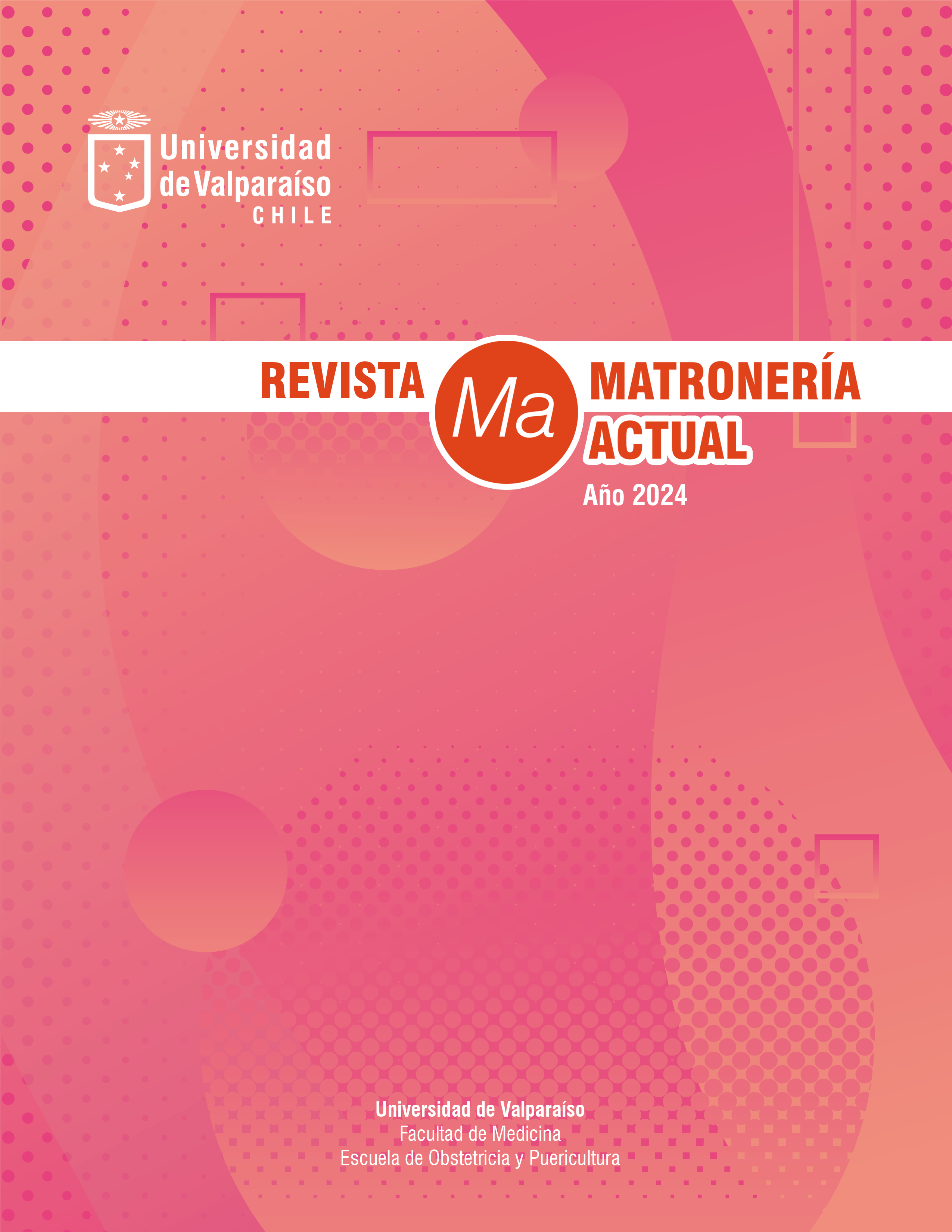MIDWIFERY CARE OF PRETERM NEWBORN WITH NECROTIZING ENTEROCOLITIS: PREVENTION AND SCREENING FOR RISK FACTORS
DOI:
https://doi.org/10.22370/revmat.1.2024.3755Keywords:
Necrotizing enterocolitis, Colostrum, Premature newborn, Neonatal intensive care unitAbstract
Necrotizing enterocolitis (NEC) is an acute inflammatory bowel disease that primarily affects the preterm newborn (PTNB) and is a leading cause of morbidity and mortality in the neonatal intensive care unit (NICU). From a clinical point of view, NEC can be difficult to distinguish from other diseases and conditions common to PTNB. In this case study we will analyze a 30-week-old PTNB, who started trophic enteral stimulation with artificial formula only at 6 days of life, without receiving breast milk at any time during his hospitalization. Subsequently evaluated by pediatric surgery; because he evolves with vomiting, bilious gastric residue and abdominal distension; associated apneas and anemia. The patient was diagnosed with Dg. of NEC in initial stage, evolving to intestinal perforation with surgical resolution. Among the midwifery care activities derived from the analysis, they include the identification of factors preponderant to NEC, especially how to initiate the trophic stimulus in the PTNB, strengthening the maternal biopsychosocial area with respect to breastfeeding. Also to identify signs and symptoms in an early and timely manner, as well as to propose improvements or strategies to reduce the incidence of this pathology.
Downloads
References
Alejandra Sandoval C. Fernanda Cofré S. Mariluz Hernández E. Caracterización clínico-epidemiológica de las enterocolitis necrosantes neonatales de siete hospitales públicos. Rev. chil. infectol. vol.37 no.6 Santiago dic. 2020.
Mena P, Mülhausen G, Novoa J, Vivanco G. Guía Nacional de Neonatología. Ministerio de Salud. Santiago, Chile. 2005. p 339-343
Estefanie Bonilla Cabana Larisa Ramírez Sandí Paulina Rojas Masís. Enterocolitis necrotizante Med. leg. Costa Rica vol.37 n.2 Heredia Sep./Dec. 2020. 3
José Luis Tapia I. y Álvaro González M, Neonatología tercera edición, Santiago, Chile, Editorial Mediterráneo 2012. c 59 p 683.
Maria Eulalia Tamayo Pérez, María Victoria Arango Rivera, Carolina Tamayo Múnera. Fisiopatología y factores de riesgo para el desarrollo de enterocolitis necrosante en neonatos menores de 1.500 g. Iatreia vol.19 no.4 Medellín Oct./Dec. 2006.
Juana M. Guzmán Cabañas, M. Dolores Ruiz González. Prevención de la enterocolitis necrotizante en el recién nacido. Unidad de Neonatología. Hospital Universitario Reina Sofía. Córdoba. España. Vol 10 N°5 páginas 295-297. Septiembre - Octubre 2012. ELSEVIER. 6
Cernadas C. Neonatología Práctica. 4th ed. Buenos Aires Bogotá: Panamericana; 2010.
Lic. Marisol Hilario Lizana. Cuidados de enfermería a pacientes con enterocolitis necrotizante. Universidad Inca Garcilaso de la Vega. Facultad de enfermería.. Lima, Perú 2017.
Juan José Gasque-Góngora. Revisión y actualización de enterocolitis necrosante.. Unidad de Neonatología, Hospital General O’Horán. Revista Mexicana de PEDIATRÍA Vol. 82, No. 5, 2015 pp 175-185.
Mϋller M J, Paul T, Seeliger S. Necrotizing enterocolitis in premature infants and newborns. J Neonatal Perinatal Med. 2016; 9 (3): 233-42. doi: 10.3233/NPM-16915130.
Buyukunal C, Kilic N, Dervisoglu S, Altug T. Abuso materno de cocaína que resulta en enterocolitis necrosante. Un estudio experimental en un modelo de rata. II. Resultados de los estudios de perfusión. Acta Paediatr Suppl 1994; 396: 91–93.
Bhatt AB, Tank PD, Barmade KB, Damania KR. J. Velocimetría de flujo Doppler anormal en fetos con restricción de crecimiento como predictor de enterocolitis necrosante. Post grado Med.2002 julio-septiembre;48(3):182-5; discusión 185.
Jorge Bordeu W., Claudio Vera P-G, MSc, Jorge Carvajal C. Dosis repetidas de corticoides prenatales para mujeres en riesgo de parto prematuro para mejorar los resultados de salud neonatal. PhD Rev. chil. obstet. ginecol. vol.76 no.6 457 – 461. Santiago 2011.
Lic. Guillermina Chattas. Cuidados al recién nacido con enterocolitis necrotizante. Revista de Enfermería Neonatal. 2009, 2(5): 14-21.
Hodzic Z, Bolock A M, Good M. The role of mucosal immunity in the pathogenesis of necrotizing enterocolitis. Front Pediatr 2017; 5:40. doi: 10.3389/fped.2017.00040.
Neu, J; Walker; A. Necrotizing Enterocolitis. N Engl J Med 2011; 364: 255-64. 16
Bathia, J. Strategies to prevent necrotising eneterocolitis. Chinese Medical Journal 2010; 123 (20): 2759-2765.
Cuenca, E; Martínez, V; Mauri, V; et al. Enterocolitis necrotizante neonatal: Factores de riesgo y morbimortalidad. Rev. de Cir. Infantil 2010. 18
Claudia Manzano A., Diana Estupiñán G., Elpidia Poveda E. Efectos clínicos de los Probióticos: Qué dice la evidencia. Rev Chil Nutr Vol. 39, N°1, Marzo 2012, págs.: 98-110.
Miranda Novales María Guadalupe. Cruz García Edgar. Uso de probióticos en Pediatría. Enfermedades Infecciosas y Microbiológicas 2012 32 (2): 74-80.
Gephart SM, Spitzer AR, Effken JA, Dodd E, Halpern M, McGrath JM. Discrimination of GutCheck(NEC): a clinical risk index for necrotizing enterocolitis. J Perinatol. 2014 Jun;34(6):468-75. doi: 10.1038/jp.2014.37. Epub 2014 Mar 20. PMID: 24651734; PMCID: PMC4420242.
Published
Versions
- 2024-09-03 (2)
- 2024-03-20 (1)
How to Cite
Issue
Section
License
Copyright (c) 2024 Revista Matronería Actual

This work is licensed under a Creative Commons Attribution-NonCommercial-ShareAlike 4.0 International License.
__



.png) Indicaciones para Autores
Indicaciones para Autores









